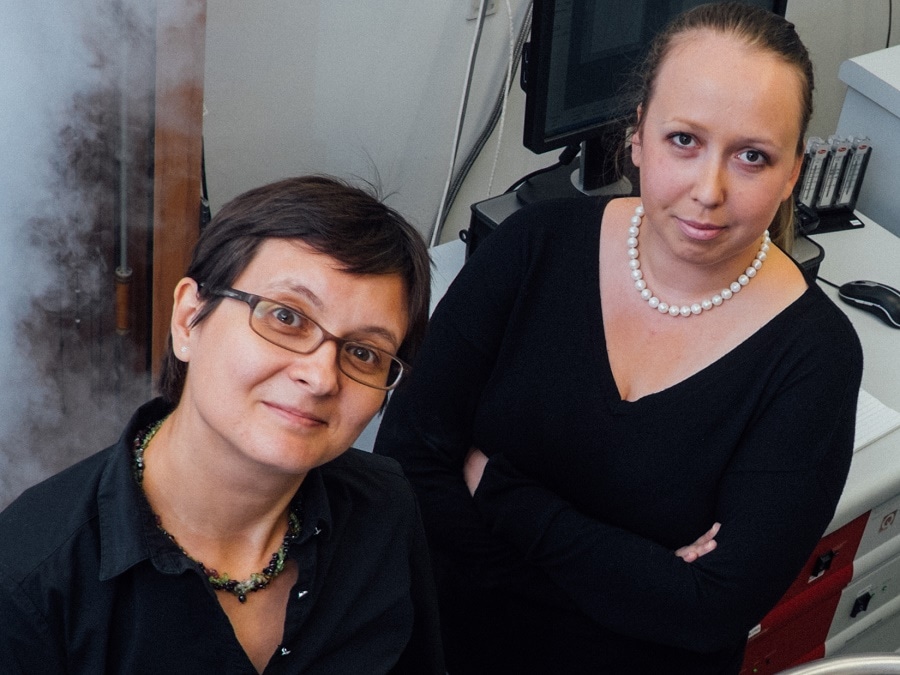Jul 22 2016
Titanium that is four times harder than steel has been discovered at Rice lab.
 Emilia Morosan (left) and Eteri Svanidze (Photo by Jeff Fitlow/Rice University)
Emilia Morosan (left) and Eteri Svanidze (Photo by Jeff Fitlow/Rice University)
Titanium is used as a key material for artificial hip and knee joints because it is durable, nontoxic and wear-resistant. However, an unpredicted discovery by Rice University physicists exhibits that the gold standard used for artificial joints can be further improved by adding some real gold.
It is about 3-4 times harder than most steels. It’s four times harder than pure titanium, which is what’s currently being used in most dental implants and replacement joints.
Emilia Morosan, Professor, Rice University
The new study in Science Advances that explains the properties of a 3-to-1 mixture of titanium and gold with a particular atomic structure that imparts hardness.
Morosan, a physicist who is a specialist in designing and synthesizing compounds with exotic magnetic and electronic properties, pointed out that new study is “a first for me in a number of ways. This compound is not difficult to make, and it’s not a new material.”
It was previously discovered that in atomic structure of the material atoms are tightly packed in the form of a cubic crystalline structure which is usually associated with hardness. It is still uncertain as to whether Morosan and former graduate student Eteri Svanidze, the study’s lead co-author, were the ones to first develop a pure sample of the ultrahard “beta” form of the compound. However, due to their good fortune they and their co-authors were the first to document the material’s exceptional properties.
This began from my core research. We published a study not long ago on titanium-gold, a 1-to-1 ratio compound that was a magnetic material made from nonmagnetic elements. One of the things that we do when we make a new compound is try to grind it into powder for X-ray purposes. This helps with identifying the composition, the purity, the crystal structure and other structural properties. When we tried to grind up titanium-gold, we couldn’t,” she recalled. “I even bought a diamond (coated) mortar and pestle, and we still couldn’t grind it up.
Emilia Morosan, Professor, Rice University
Morosan and Svanidze decided to conduct a number of tests to determine the exact hardness of the compound and they also planned to determine the hardness of the other compositions of gold and titanium, which was used as comparisons in the original research. One of the extra compounds was a combination of three parts titanium and one part gold that had been developed at high temperature.
The team had not discovered at the time that making titanium-3-gold at comparatively high temperature has the capability to produce a pure form of crystalline of the beta version of the alloy which is a crystal structure that is four times harder than titanium. When exposed to lower temperatures, the atoms allow themselves to be arranged in another cubic structure which is the alpha form of titanium-3-gold. The alpha structure is equally hard when compared to regular titanium. Labs that measured the hardness of titanium-3-gold previously had measured samples that largely consisted of the alpha arrangement of atoms.
The group determined the hardness of the beta form of the crystal in association with colleagues at the National High Magnetic Field Laboratory at Florida State University and at the Texas A&M University’s Turbomachinery Laboratory, Morosan and Svanidze also conducted other comparisons with titanium.
For example, with biomedical implants the two key measures are biocompatibility and wear resistance. Since gold and titanium are among the most biocompatible metals and are usually implemented in medical implants, the researchers believed that titanium-3-gold could be compared. In a point of fact, tests conducted by researchers at the University of Texas MD Anderson Cancer Center in Houston established that the new alloy was even better in terms of biocompatibility when compared to pure titanium. The result was similar even in wear resistance: Titanium-3-gold outmatched pure titanium.
Morosan said she did not plan on becoming a materials scientist or entirely change her lab’s focus, however she said her team is planning to conduct a series of tests to further investigate the crystal structure of beta titanium-3-gold and to observe if chemical dopants could be further improved in terms of hardness.
Other co-authors include Pulickel Ajayan, Sruthi Radhakrishnan and Chandra Sekhar Tiwary, all of Rice; Tiglet Besara, Yan Xin, Ke Han and Theo Siegrist, all of Florida State; Fevzi Ozaydin and Hong Liang, both of Texas A&M; and Sendurai Mani of MD Anderson. The research was supported by the National Science Foundation, the Department of Energy, Texas A&M’s Turbomachinery Laboratory and the Florida State University Research Foundation.